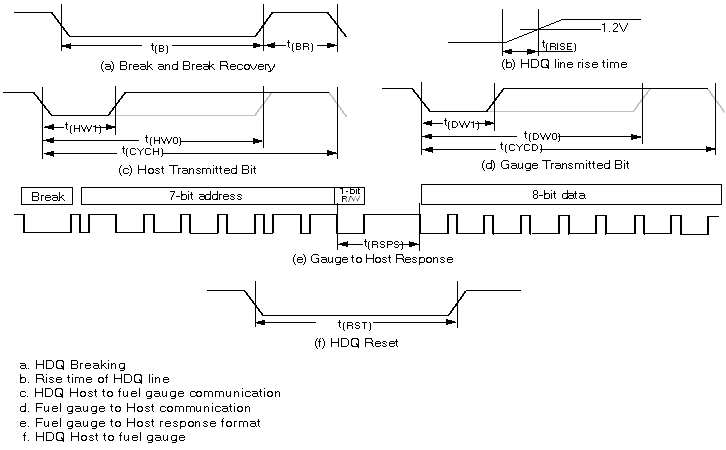SLUSDW2A November 2021 – February 2022 BQ27Z746
PRODUCTION DATA
- 1 Features
- 2 Applications
- 3 Description
- 4 Revision History
- 5 Pin Configurations and Functions
- 6 Specifications
-
7 Detailed Description
- 7.1 Overview
- 7.2 Functional Block Diagram
- 7.3
Feature Description
- 7.3.1 BQ27Z746 Processor
- 7.3.2 Battery Parameter Measurements
- 7.3.3 Power Supply Control
- 7.3.4 Bus Communication Interface
- 7.3.5 Low Frequency Oscillator
- 7.3.6 High Frequency Oscillator
- 7.3.7 1.8-V Low Dropout Regulator
- 7.3.8 Internal Voltage References
- 7.3.9 Overcurrent in Discharge Protection
- 7.3.10 Overcurrent in Charge Protection
- 7.3.11 Short-Circuit Current in Discharge Protection
- 7.3.12 Primary Protection Features
- 7.3.13 Battery Sensing
- 7.3.14 Gas Gauging
- 7.3.15 Zero Volt Charging (ZVCHG)
- 7.3.16 Charge Control Features
- 7.3.17 Authentication
- 7.4 Device Functional Modes
- 8 Applications and Implementation
- 9 Power Supply Requirements
- 10Layout
- 11Device and Documentation Support
- 12Mechanical, Orderable, and Packaging Information
Package Options
Mechanical Data (Package|Pins)
- YAH|15
Thermal pad, mechanical data (Package|Pins)
Orderable Information
6.7 Digital I/O: Timing Characteristics
| PARAMETER | TEST CONDITIONS | MIN | NOM | MAX | UNIT | |
|---|---|---|---|---|---|---|
| I2C Timing — 100 kHz | ||||||
| fSCL | Clock Operating Frequency | SCL duty cycle = 50% | 100 | kHz | ||
| tHD:STA | START Condition Hold Time | 4.0 | µs | |||
| tLOW | Low period of the SCL Clock | 4.7 | µs | |||
| tHIGH | High period of the SCL Clock | 4.0 | µs | |||
| tSU:STA | Setup repeated START | 4.7 | µs | |||
| tHD:DAT | Data hold time (SDA input) | 0 | ns | |||
| tSU:DAT | Data setup time (SDA input) | 250 | ns | |||
| tr | Clock Rise Time | 10% to 90% | 1000 | ns | ||
| tf | Clock Fall Time | 90% to 10% | 300 | ns | ||
| tSU:STO | Setup time STOP Condition | 4.0 | µs | |||
| tBUF | Bus free time STOP to START | 4.7 | µs | |||
| I2C Timing — 400 kHz | ||||||
| fSCL | Clock Operating Frequency | SCL duty cycle = 50% | 400 | kHz | ||
| tHD:STA | START Condition Hold Time | 0.6 | µs | |||
| tLOW | Low period of the SCL Clock | 1.3 | µs | |||
| tHIGH | High period of the SCL Clock | 600 | ns | |||
| tSU:STA | Setup repeated START | 600 | ns | |||
| tHD:DAT | Data hold time (SDA input) | 0 | ns | |||
| tSU:DAT | Data setup time (SDA input) | 100 | ns | |||
| tr | Clock Rise Time | 10% to 90% | 300 | ns | ||
| tf | Clock Fall Time | 90% to 10% | 300 | ns | ||
| tSU:STO | Setup time STOP Condition | 0.6 | µs | |||
| tBUF | Bus free time STOP to START | 1.3 | µs | |||
| HDQ Timing | ||||||
| tB | Break Time | 190 | µs | |||
| tBR | Break Recovery Time | 40 | µs | |||
| tHW1 | Host Write 1 Time | Host drives HDQ | 0.5 | 50 | µs | |
| tHW0 | Host Write 0 Time | Host drives HDQ | 86 | 145 | µs | |
| tCYCH | Cycle Time, Host to device | device drives HDQ | 190 | µs | ||
| tCYCD | Cycle Time, device to Host | device drives HDQ | 190 | 205 | 250 | µs |
| tDW1 | Device Write 1 Time | device drives HDQ | 32 | 50 | µs | |
| tDW0 | Device Write 0 Time | device drives HDQ | 80 | 145 | µs | |
| tRSPS | Device Response Time | device drives HDQ | 190 | 950 | µs | |
| tTRND | Host Turn Around Time | Host drives HDQ after device drives HDQ | 250 | µs | ||
| tRISE | HDQ Line Rising Time to Logic 1 | 1.8 | µs | |||
| tRST | HDQ Reset | Host drives HDQ low before device reset | 2.2 | s | ||
 Figure 6-1 I2C Timing
Figure 6-1 I2C Timing Figure 6-2 HDQ Timing
Figure 6-2 HDQ Timing